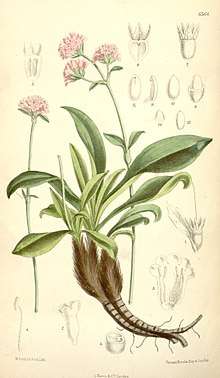Nardostachys jatamansi
| Spikenard | |
|---|---|
 | |
| Scientific classification | |
| Kingdom: | Plantae |
| Clade: | Angiosperms |
| Clade: | Eudicots |
| Clade: | Asterids |
| Order: | Dipsacales |
| Family: | Caprifoliaceae |
| Genus: | Nardostachys |
| Species: | N. jatamansi |
| Binomial name | |
| Nardostachys jatamansi | |
| Synonyms[1] | |
| |
Nardostachys jatamansi is a flowering plant of the Valerian family that grows in the Himalayas. It is a source of a type of intensely aromatic amber-colored essential oil, spikenard. The oil has, since ancient times, been used as a perfume, as a medicine and in religious contexts. It is also called spikenard, nard, nardin, or muskroot. Mounting evidence shows that it is critically endangered (as rated by the IUCN) in the wild due to overharvesting for medicine, overgrazing, loss of habitats, and forest degradation.
Description
Nardostachys jatamansi is a flowering plant of the honeysuckle family that grows in the eastern Himalayas, primarily in a belt through Kumaon, Nepal, Sikkim and Bhutan.[2] The plant grows to about 1 m in height and has pink, bell-shaped flowers. It is found in the altitude of about 3000–5000 meters. Rhizomes (underground stems) can be crushed and distilled into an intensely aromatic amber-colored essential oil, which is very thick in consistency. Nard oil is used as a perfume, an incense, a sedative, and an herbal medicine said to fight insomnia, birth difficulties, and other minor ailments.[3]
Phytochemistry
The chemical components of Nardostachys jatamansi have been assayed in a number of different studies. These compounds include:[4]
- acaciin
- ursolie acid
- octacosanol
- kanshone A
- nardosinonediol
- nardosinone
- aristolen-9beta-ol
- oleanolic acid
- beta-sitosterol
Historical use
Nardostachys jatamansi may have been used as an ingredient in the incense known as spikenard, although lavender has also been suggested as a candidate for the spikenard of classical times. It also has a variety of purported uses in the state of Sikkim located in Northeastern India.[5]
References
- ↑ "Nardostachys jatamansi", The Plant List, retrieved 2014-09-19
- ↑ Bakhru, H.K. (1993). Herbs that heal : natural remedies for good health (3rd print. ed.). New Delhi u.a.: Orient Paperbacks. p. 117. ISBN 978-8122201338.
- ↑ Dalby, Andrew (2000), Dangerous Tastes: the story of spices, London: British Museum Press, ISBN 978-0-7141-2720-0 (US ISBN 0-520-22789-1) pp. 83–88
- ↑ Zhang, X; Lan Z; Dong XP; Deng Y; Hu XM; Peng T; Guo P. (January 2007). "Study on the active components of Nardostachys chinensis". Zhong Yao Cai. 30 (1): 38–41. PMID 17539300.
- ↑ O'Neill, Alexander; et al. (2017-03-29). "Integrating ethnobiological knowledge into biodiversity conservation in the Eastern Himalayas". Journal of Ethnobiology and Ethnomedicine. 13 (21): 21. doi:10.1186/s13002-017-0148-9. PMC 5372287. PMID 28356115.
External links
| Wikisource has the text of the 1911 Encyclopædia Britannica article Spikenard. |
- Original botanical description by David Don from Prodromus Florae Nepalensis (1825), in Latin (archived by the Biodiversity Heritage Library)
- Caldecott, Todd (2006). Ayurveda: The Divine Science of Life. Elsevier/Mosby. ISBN 978-0-7234-3410-8. Contains a detailed monograph on Nardostachys grandiflora, N. jatamansi (Jatamamsi) as well as a discussion of health benefits and usage in clinical practice. Available online at http://www.toddcaldecott.com/index.php/herbs/learning-herbs/354-jatamamsi
- Celtnet Spice Guide information page for spikenard
